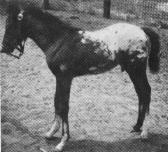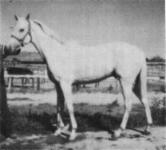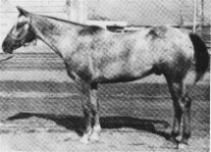Both non-Appaloosa roan and non-Appaloosa gray destroy
the typical colorful coat pattern of the Appaloosa. The Appaloosa has many good qualities,
but the asset that attracts the most new interest is his unusual and eye-catching coat
markings. Many of the Appaloosa results of crosses to grays turn gray and then white,
and the results of crosses to non-Appaloosa roans often show a drab uniform roan without
the sharp contrast of a typical Appaloosa pattern.
These facts are confirmed by Jones and Bogart in the book
Genetics of the Horse. They state:
"Gray in horses is dominant to non-gray. Foals with the gray gene (G)
are born pigmented but start showing gray with the first shedding of hair. Gray horses
show more gray with age and may become completely white in old age.
"Horses of all colors may be gray but draft horse breeders are more familiar with
black gray that occurs in the Percheron. Percheron horses are usually black and the G
gene gives a black gray. When the gray gene is present in bay horses it gives a red gray
and in chestnut colored horses the gray gene results in chestnut gray animals. The gray
gene is palominos will tend to cause them to appear lighter and eventually to appear
white at the horse ages. The gray gene can mask the Appaloosa pattern by causing the
dark spots on the white background or the dark background in which there are white spots
to become light or white.
"As pigment is removed from the hair by the gray gene, it sometimes accumulates in
the skin about the anus and in the big gut of the horse. If melanomas develop in the
colon or big gut, there can be strangulation which may cause death.
"The Rn Locus. Roan may occur in any color. There are black roans (often referred
to as blue roans), bay roans (often referred to as strawberry roans), chestnut roans,
sorrel roans and palomino roans. The roan gene tends to make the golden color of the
palomino less attractive because of the interspersion of white hairs. The Appaloosa
pattern is damaged greatly by the roan gene because roaning in the dark spots on a white
background on in the dark background in which white spots occur interfere with the
sharpness of the spots. Also, when the roaning is in interspersion of small clumps of
white hairs with the pigmented, it tends to give two kinds of white spots on a colored
background."
Other results of these crosses resemble the non-Appaloosa
parent and are non-Appaloosa gray or roan. Being gray or roan, the horse does have some
white hairs, so the owner assumes an Appaloosa has been produced. When an Appaloosa
breeder sells a non-Appaloosa gray or roan to a new potential Appaloosa breeder and the
horse cannot be registered, a customer has been lost and the breed has suffered.
Why do some Appaloosa breeders cross to non-Appaloosa
grays and roans?
It is probably because the breeder expects to get a higher
percentagce of Appaloosa foals. The genetic study by Robert Miller proved this to be
incorrect. He found no significant differences in the percentage of Appaloosas produced by
crossbreeding to one color over another color.
It is true there is a small percentage of outstanding
grays and roans in both Quarter Horses and Thoroughbreds, and there are many outstanding
grays in the Arabian breed. Arabians have quite a high percentage of grays. The same is
true for Percherons, and the Lipizzan breed is almost entirely gray. A high percentage of
roans occurs in Belgian draft horses.
Grays and roans are fine for people who enjoy grays and
roans. With the Appaloosa, the objective is to produce a horse that looks like an
Appaloosa rather than like a non-Appaloosa gray or roan.
Some people claim they cross to non-Appaloosa grays and
roans to obtain speed or some other elusive quality. If a breeder desires to cross to a
certain bloodline, some of which are non-Appaloosa gray or roan, it is nearly always
possible to find breeding stock in the line that is solid chestnut, bay, brown or
black.
The percentage of grays and roans among outstanding
horses in the breeds most crossed to is very low. Of the 642 prominent racing
Thoroughbreds listed in the Thoroughbred Record's statistical report for 1975,
only 3% were roan and 5% were gray. Of the 78 Quarter Horses in the Quarter Racing
World's stallion register for 1975, only two were roans and one was gray.
Most breeders do not want the right to make crosses that
might destroy the breed. This June a Paint horse outran an outstanding Appaloosa race
horse. No one recommended or even considered rescinding the Paint or Pinto rule. The
Paint pattern, like the gray and the non-Appaloosa roan, is not compatible with the
Appaloosa pattern.
For many years the Appaloosa breed has benefited from
rules that prevented crossbreeding to Pintos, Paints, albinos and figures 9-21 roans
(sometimes called savina or sabina roans). Not allowing these crosses has helped keep
the Appaloosa "looking like an Appaloosa." The parrot-mouth rule and the
cryptorchid-monorchid rule have helped improve the soundness of the Appaloosa. When the
rule disallowing crosses to figures 9-21 roans was passed in 1959, a few people loudly
objected because they were using such horses in their breeding programs. There were also
a few objections voiced by owners of cryptorchids and monorchids when those rules were
put into effect.
Registration rules are developed for the long-term benefit
of both the breed and the breeder. The gray-roan rule will eliminate the two crosses
that are presently causing the most serious problems in the Appaloosa breed.
The rule will have no effect on the Appaloosas already
registered that carry graying or roaning. It will prevent the introduction of more gray
and non-Appaloosa roan into the breed.
Why is the introduction of additional gray and
non-Appaloosa roan from outside the breed of more concern to serious breeders now than in
the past?
In 1955 the percentage figures for grays within the
Appaloosa breed were only aroung 1.6%. In 1962 when the pamphlet "Crosses That
Will Kill Your Color" was published, there were less than 20,000 horses registered
and of that, about 4% to 6% were the results of crosses to grays and roans.
In 1975, only 13 years later, with over 200,000 horses
registered, the percentage of gray/non-Appaloosa roans within the breed has climbed to
about 10% ... TODAY WE HAVE MORE GRAYS AND NON-APPALOOSA ROAN CROSSES WITHIN THE
APPALOOSA REGISTRY THAN WE HAD TOTAL APPALOOSAS REGISTERED 13 YEARS AGO!
When the president of the Australian Appaloosa Assn., Noel
Cook, first visited the Appaloosa ranches in the United States, he was aghast at the
number of faded-out (graying gene) Appaloosas resulting from crosses to grays. One of
the first rules passed by the newly-formed Australian Appaloosa Assn. was to not accept
crosses to grays for registry. The British Appaloosa Society also has a rule
disallowing crosses to grays.
Why not let the buyer beware?
Some breeders who are presently using non-Appaloosa grays
and roans state that it is not the registry's problem to protect the customer. If an
uninformed buyer purchases an Appaloosa with graying that soon turns white, or a
non-Appaloosa roan that is ineligible to register, that is the buyer's problem.
Unfortunately, most new buyers do not avail themselves of
the information that is available. They have not read "Crosses That Will Kill Your
Color" or "Grays and Non-Appaloosa Roans," pages 22-24 in the March 1976
Appaloosa News. Unfortunately for the Appaloosa breeders who do have concern for the
breed and the market, the disenchanted customer is vocal about his disappointing
experience with the breed and discourages other potential investors in Appaloosas.
How can we protect the investment of the Appaloosa
breeder who has purchased a non-Appaloosa gray or roan of another breed to use in his
Appaloosa breeding program?
Breeders who took this course ignored the registry
recommendations that have been available since 1962. Their investment was in a
non-Appaloosa, a horse of another breed. If their non-Appaloosa horse was worth
a certain figure for use in crossbreeding, it should be worth the same amount within its
own breed. If it is not, then it was oversold.
Is there a connection between the leopard pattern and
graying or roaning?
No. All patterns of Appaloosas have been mated to
non-Appaloosa roans and grays and the pattern of Appaloosa crossed with does not appear
to affect the expression. Graying is no more prevalent in one pattern than in another.
Some leopard to leopard matings produce a foal that is predominately white with some
color in the flanks, feet and head. This should not be confused with graying.
Do the Appaloosa Horse Club progeny records confirm that
gray to non-gray matings produce 50% grays?
Yes. Following is an example of the records of a
stallion that resulted from an Appaloosa being bred to a non-Appaloosa gray mare:
"Stallion A was popular in the early 1960's, having 125 registered get
this far -- 64 being gray and 61 non-gray. Several of his graying sons (first
generation males) are:
"Son 1" sired 22 grays vs. 24 non-grays before he was gelded; "Son 2"
sired 16 grays vs. 14 non-grays; "Son 3" sired 12 grays vs. 16 non-grays;
"Son 4" sired 9 grays vs. 13 non-grays; "Son 5" sired 5 grays vs. 2
non-grays.
On the distaff side of "Stallion A," the same genetic trait shows up in his
better-known graying daughters that are also producing (first generation
females):
"Daughter 1" produced 4 grays vs. 2 non-grays; "Daughter 2" produced 2
grays vs. 3 non-grays; "Daughter 3" produced 3 grays vs. 1 non-gray;
"Daughter 4" produced 3 grays vs. 2 non-grays; "Daughter 5" produced
2 grays vs. 0 non-grays.
This example shows how much graying can be introduced into
the breed from one cross to a non-Appaloosa gray.
Examples of the problems that arise from crosses to
non-Appaloosa grays and roans are very evident in the Appalosoa Horse Club pedigree
records. The board of directors is having the genetic study made so these problems can
be confirmed, analyzed and explained by a geneticist.
There is still much to be learned about the genetics of
the Appaloosa coat pattern. The board agrees there should be continued work in that
area. The genetics of non-Appaloosa gray and roan have been worked out for many years.
The adverse effect of both on the Appaloosa is well documented by Jones and Bogart on
page 296 of Genetics of the Horse. The pedigree records of the Appaloosa Horse
Club confirm these facts.
The current members of the Appaloosa Horse Club board of
directors have bred and/or owned a total of 1,400 registered Appaloosa horses. In
addition to their experience in Appaloosa breeding, directors make registration rules
and policy based on recommendations from members, on registry statistics, on experience
with inspections and on handling problem cases. They see firsthand the scope and
importance of the tragic result of crossing to non-Appaloosa roans and grays.
We should heed to a not-too-ancient example of the
graying gene at work -- take the case of the Lipizzans:
Around 1800, when the Austrian emperor decided he didn't
like spotted and dark-colored horses, he handed down the ultimatum that all his horses
were to be white! Five white stallions were imported and used as herd sires. We all
know the result -- most of the specially-trained Lipizzans of today are white even
though they are all born dark (some with strong Appaloosa characteristics). Nearly all
fade rapidly to a light gray within three or four years.
Why are gray and roan lumped together?
Non-Appaloosa gray and roan are inherited in much the
same way as both are epistatic. They are confused in the descriptions of other breeds.
Many Quarter Horses and Thorughbreds are registered as "roan" when, in truth,
they are "gray" of gray parents.
Since both produce an interspersion of white hairs with
colored hairs, they cause some of the same problems in Appaloosa breeding and
identification. Gray destroys the Appaloosa marking by the horse turning white and
roaning destroys the Appaloosa pattern by eliminating the contrast in the spots and
varnish marks.
It has been stated that horses with graying are subject
to melanoma. How well is this documented?
Nearly all texts on equine medicine an genetics mention
the melanoma problem in horses with graying. Following are examples.
The melanoma problem in grays is confirmed by A.G. Searle
in his book Comparative Genetics of Coat Colour in Mammals. He states:
"It is interesting to note that G (gene for gray) has an unfavorable pleiotropic
effect, for gray horses are exceptionally prone to skin cancers, in the form of
melanomata (Hawden, 1931; Cotchin, 1956; Pack et. at., 1963)."
Dr. E.J. Catcott and J.F. Smithcors in Progress in
Equine Practice state:
"Both benign and malignant melanomas are very common in gray horses ...
The incidence of melanomas in such animals increases steadily after they become 6 years
of age."
If the Appaloosa Club retains the gray-roan rule,
will breeders with no consideration for the registry rules or the future of the breed
continue to crossbred to non-Appaloosa grays and roans and register the results to
another horse?
Not likely. See the article "Use of Blood Typing to
Confirm Principles fo Coat Color in Horses," The Journal of Heredity,
67:6-19, 1976, by Smith, Suzuki and Stormont. This article cites work done on parentage
cases where the color of the resulting foal in relation to the color of its parent appeared
to be an exception to the genetic rules. In nearly all cases, the parentage was
proven incorrect. Chestnut to chestnut matings do not produce a bay, and one parent must
be a gray in order to produce a gray. Ignoring the rules would be risky as the color of
the resulting foal would prove fraud in the pedigree. This could be further confirmed
by blood testing.
All references substantiating this article and past
articles published by the Appaloosa Horse Club on the fallacy of crossing to grays and
non-Appaloosa roans were from material already printed. No statements were solicited
to try and prove a point. The serious problems cited here were already well documented
in the literature.
A vote to discontinue the gray-roan rule is a vote for a
short term financial benefit to owners of non-Appaloosa roans and grays.
A vote to keep the rule is a vote for the long term
benefit of the Appaloosa breed and the Appaloosa market.



